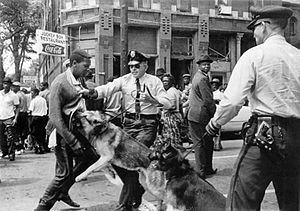Birmingham Alabama — Monday May 14th, 2012, Gonzeaux #7
It’s an image that was so arresting and shocking at the time that I’ve never forgotten it. It stained my memory like indigo on fine white linen, never to be washed out. I was nine years old. I’m talking about the sight, on national television, of black people being attacked by German Shepard’s in the Birmingham, Alabama race riots of 1963. The high-pressure water hoses were cruel, but the dogs, those vicious dogs, made my skin crawl, and it flipped a switch in my head. From that point forward I was a social progressive.
I’ve not ever visited Alabama. I’ve been to nearly every state in the USA, but never had a reason to come here, and if someone had suggested it, I probably would have found a reason not to go. My visit now is deliberate. It will be nearly 50 years since I saw those people fighting for their rights. This Gonzeaux trip has been about seeing what’s happening in the states with regard to innovation, so, I elected to visit Alabama and see what’s going on now, it’s only fair.
Innovation is not just about invention and corporate profit is it? Innovation is fundamentally about change, improvement, and doing things differently for the benefit of all. Social innovation is perhaps the most challenging innovation of all. Fighting for civil rights was a tough business in 1963. It meant beatings, humiliation, even death. Make no mistake, those courageous black people on the streets in Birmingham were innovators of the first order.
What questions would those courageous people have for the experts and corporate change mavens attending the Front End of Innovation in 2012? Would their questions be about opportunity to play? Or would they focus on simple social dignity — has that been achieved in the corporate world?
Birmingham today seems like a bit of a shell city. There was a new music festival happening downtown but to be honest, other than the people watching, I couldn’t relate. Twenty minutes of a screaming white rapper were all I could handle. So, I visited the park where the race incidents occurred, and, the Birmingham Civil Rights Institute. The fact that the museum exists at all is a testimony to how far Alabama has come. The museum presented more images I won’t soon be able to forget. Side by side water fountains, one cooled, one a passive tap, one for whites, the other for colored. Didn’t know the Birmingham police had tanks, yes tanks, in their arsenal to maintain segregation. Growing up in the north this divide was not nearly so well defined, although I do recall blacks dutifully going to the back of the bus in Cincinnati. I’m not saying us northerners were holier than thou, clearly, we were not. We had our color line as well.
In the park across the street, where the incidents happened, there were two sculptures that featured the attack dogs. Both sent shivers up my spine.
I have no idea what’s going on in Alabama with regard to business or science innovation. The days when NASA had a big presence here are over. Modern day entrepreneurs here could do worse than to model the success of the late businessman A.G. Gaston. I hope to do another post on him later. I will say that the first order of business has now been taken care of — racism may still exist, but overt discrimination is over. To put it simply, folks here have a fighting chance for their share of the American dream. I’d hope that Alabama will present the USA and the world with another image, one for the future, an image of innovation, that will bring a smile to our faces. Happy to post it here first!
Onto Georgia.



